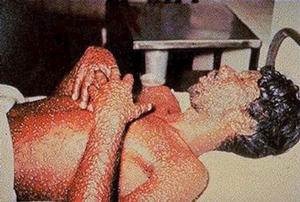BiodefenseDebate intensifies over whether or not to destroy last stockpile of smallpox
The world’s health ministers are scheduled to meet later this month to discuss the fate of the last known stockpiles of smallpox, held under tight security in two labs— one in the United States and the other in Russia. Smallpox has been eradicated for more than three decades, but some U.S. health officials say the remaining stockpiles should be kept for further studies. The smallpox virus is being used to develop drugs and safer vaccines in case the virus returns through terrorism or a lab accident. Member nations of the World Health Organization (WHO) once agreed that the last virus strains known to officials would eventually be destroyed, but a set date was never agreed upon.

The ravages of smallpox // Source: vt.edu
The world’s health ministers are scheduled to meet later this month to discuss the fate of the last known stockpiles of smallpox, held under tight security in two labs— one in the United States and the other in Russia.
Smallpox has been eradicated for more than three decades, but some U.S. health officials say the remaining stockpiles should be kept for further studies. The smallpox virus is being used to develop drugs and safer vaccines in case the virus returns through terrorism or a lab accident. Member nations of the World Health Organization (WHO) once agreed that the last virus strains known to officials would eventually be destroyed, but a set date was never agreed upon.
Columbia Daily Tribune reports thatlast fall, two WHO committees reviewed smallpox research and one group found no further need for the smallpox virus. “We believe that the smallpox research program is effectively complete and the case for destruction is stronger than ever,” said Lim Li Ching, on behalf of the Third World Network, which lobbies on behalf of developing countries and wants the virus eliminated within two years.
Keeping the virus on hand is scientifically unnecessary now that the virus’ genetic makeup is known, said Dr. D. A Henderson, former head of the WHO’s global eradication campaign and now with the nonprofit UPMCCenter for Health Security. “Let’s destroy the virus and be done with it. We would be better off spending our money in better ways,” such as protecting against other viruses that could be used for bioterrorism.
The Centers for Disease Control and Prevention (CDC) poxvirus chief Dr. Inger Damon disagrees with eliminating the virus, since smallpox research has aided in recognition and treatment of related diseases such as monkeypox. There are now new generations of smallpox vaccine, and two pending antiviral treatments, but Damon wrote in the journal PLoS Pathogens that “despite these advances, we argue that there is more to be done” in improving protections.
A recent WHO meeting raised concerns about advances in synthetic biology, which could make it technologically possible to design a synthetic version of smallpox. “The synthetic biology adds a new wrinkle to it,” Jimmy Kolker, Health and Human Services assistant secretary for global affairs, told the AP. “We now aren’t as sure that our countermeasures are going to be as effective as we’d thought even five years ago.”
In response, Dr. Sylvie Briand, WHO’s director of pandemic diseases, cautioned that synthetic biology is “not something you can do in your garage.” She insists that destroying the smallpox virus is not the fundamental issue, instead “the real debate is what is the public health risk nowadays, and what are the response measures we have in hand to mitigate those risks.”
